Part 11: 2880-2900-The First Galactic Unification Summit
The First Galactic Unification Summit
Spurred by the threat presented by the Klackon and the Unified State, the United Republic throws itself into a wide program of military preparations. The newly-elected Conservative leadership in the Great Senate tasks money for weapons research and fortifications across the Republic. Within a year of the elections, in 2881, researchers working for Cydonian Waste Solutions, Limited develop designs for a network of installations that serve to actively circulate local air currents through them and scrub hazardous particulates and vapors, greatly reducing the total pollution that must be disposed of in other fashions when installed around industrial zones on a world.


That same year, the RES Sir Francis Drake makes an incredible discovery. In orbit around an otherwise unremarkable star system near the borders of the Unified State, they find a crippled ship of unfamiliar design, with slightly over a thousand aliens of a type never before encountered crewing it. After communication is established, it is discovered that they are Psilons from the Union of Peace in the far galactic northeast. The leader of this vessel, Kirsus, one of the finest minds of the Union of Peace, was seeking to verify mathematical predictions that hyperspace conduits may temporarily form in hyperspace near black holes. She reports that the mathematical predictions were indeed correct- and that the navigational hazards involved are far too dangerous for this to be exploited. She and her crew had been waiting in orbit in the system they were flung to, living on ship's stores and expecting to die in the far unknown. Given rescue, the Psilons choose as a mass to naturalise as citizens of the United Republic, and eventually form a small Psilon subcommunity on New Greenland. This loss to the Union of Peace is the United Republic's gain- Kirsus is a brilliant researcher who has assembled a crew of brilliant researchers, and these few Psilons bring immense contributions to Republican science.
The program of military developments has not stopped civilian endeavors- in 2883 Wotan is colonised by settlers passing through New Greenland.

In 2886, research into field physics by Williamson-Lin in the hope of developing a new generation of naval coilguns brings unexpected fruit- not only have weapons designs been refined, but they develop the 'gravitic repulsor', a cheap and compact device capable of generating a force opposed to local gravitational fields. The need for aerodynamic lift in air vehicles immediately becomes irrelevant, and the line between ground and air vehicles blurs dramatically. Civilian light flyers begin to supplant earlier wheeled automotive transport, and the new generation of military vehicles which combine armor appropriate to ground vehicles with maneuverability both on ground and air drive a revolution in surface war tactics.


With the new refinements to weapons design, new designs are developed for the Vigilant-class and the new Philadelphia-class vessels. The Vigilant and Alert are decommissioned for refit, while shipyards around Earth begin work on the Philadelphia. Although the revised design for the Vigilant-class sacrifices one secondary turret, it now incorporates Isozaki Metal framing and armor, the velocity of the projectile of its primary turret is greatly increased to more effectively punch through armor, and it incorporates the heavy active sensors and targeting algorithms the Navy had hoped to use to improve combat efficiency.
The Philadelphia, for its part, mounts three primary turrets, two fore and one aft, all launching projectiles at the new armor-piercing velocities. Four secondary armor-piercing turrets and two light defensive turrets complete its armament. It incorporates the same active sensor technology, and mounts significantly heavier armor than the Vigilant-class. With three times the armor and three times the primary offensive firepower of a Vigilant, the Philadelphia alone should more than double the combat effectiveness of the Republican Star Navy.
Researching further into the same field of technology that gives you a ship weapon or system helps to miniaturise it, reducing its cost and space used. Furthermore, certain weapon modifications require certain levels of minaturisation to be applied to a weapon. With one level of miniaturisation, the one option mass drivers gain is armor-piercing, which is very, very effective in killing enemy vessels faster. I gladly suck up the extra cost and space to make offensive weapons on my ships armor-piercing.

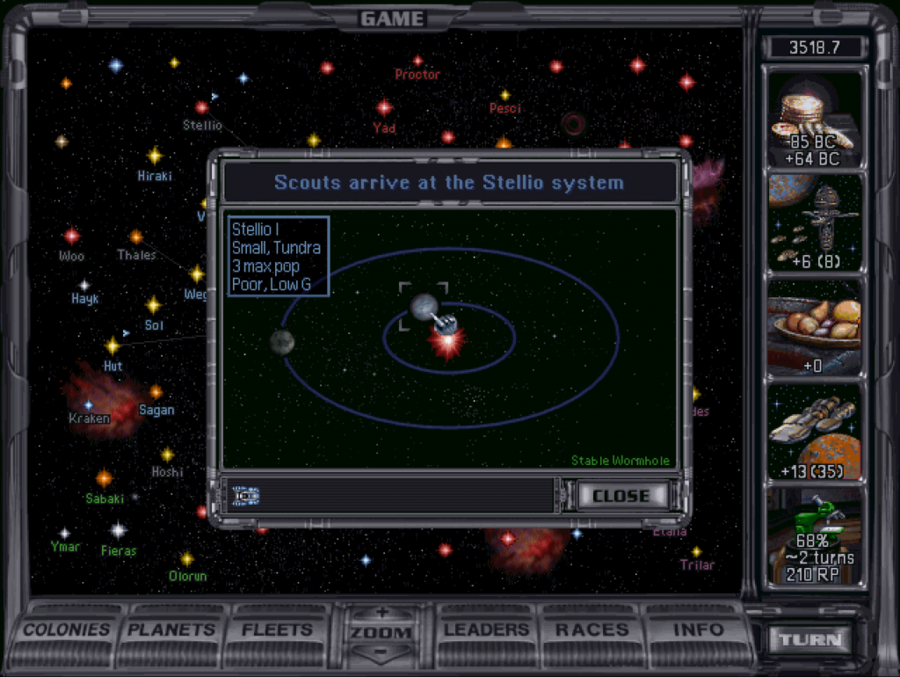
Within a year, a colonial mission to Hiraki establishes itself on the surface of Sheol, its primary colonisable planet, the refit of the Vigilant is complete, and the RES Leifr Eriksson has scouted out the Stellio system, discovering a new stable hyperspace conduit there. It proves that this is enough to bring the United Republic into contact with two other alien species.
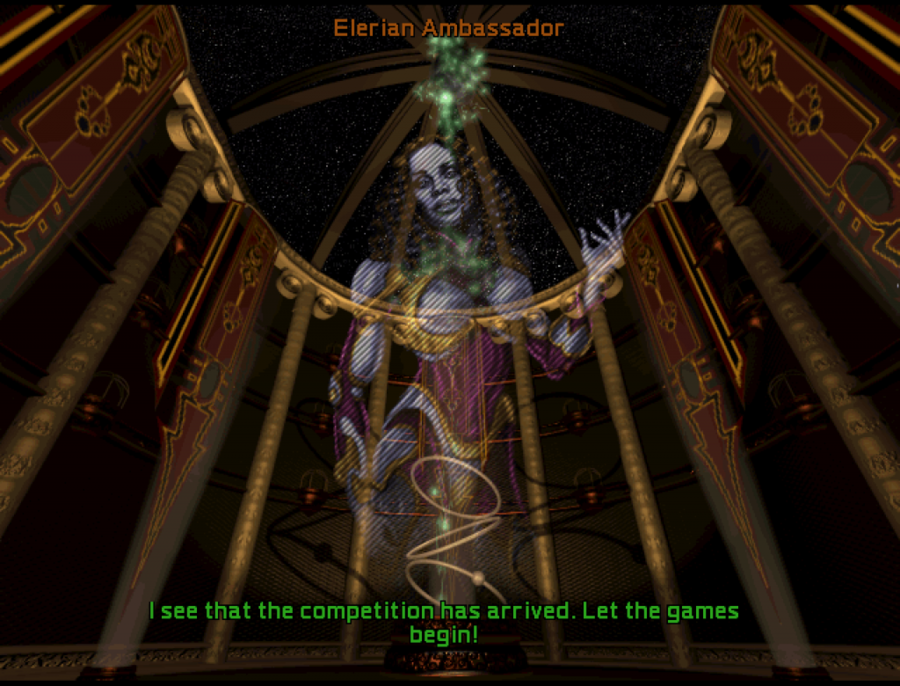
Around Hiraki, a dormant communications probe activates as the colonial fleet enters the system, broadcasting the following message in perfect English:
"High Matron Greywind of the Enlightened Council of Matrons welcomes you, Humans of the United Republic. Though you are mighty, know that even this she has forseen, through the wisdom of the Philosophers. Human might is not the only might that can draw blood; Elerian blades are still sharp. Be forewarned of this!"

Meanwhile, communications probes through the hyperspace conduit rapidly brings a response from another alien race in International Court Sakkra.
"On behalf of the Star Empire, our sincerest hopes for cordial and honorable relations between our two governments. It seems unthinkable that our fundamental interests should be in conflict, given the wide separation between our spheres of colonisation, and we are confident that Emperor Everial, Captain of the People of Trilar, shall support all negotiation in good faith for honorable peace and friendship between our peoples."
The Republican government is shaken by the announcement from the Elerian Council of Matrons, and chooses to maintain a diplomatic distance from them. The Star Empire, however, invites and recieves friendly treatment.


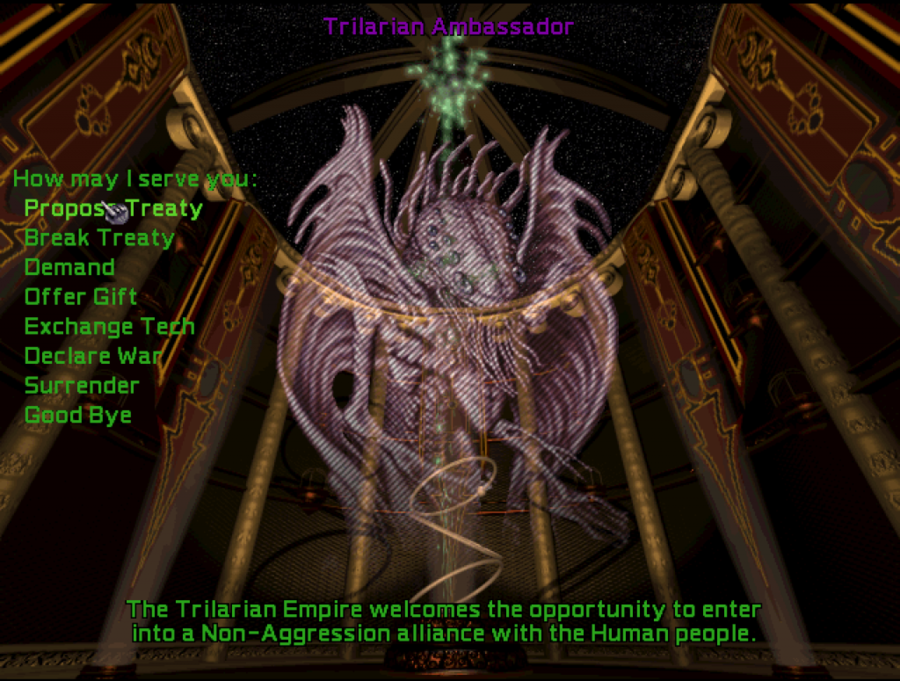
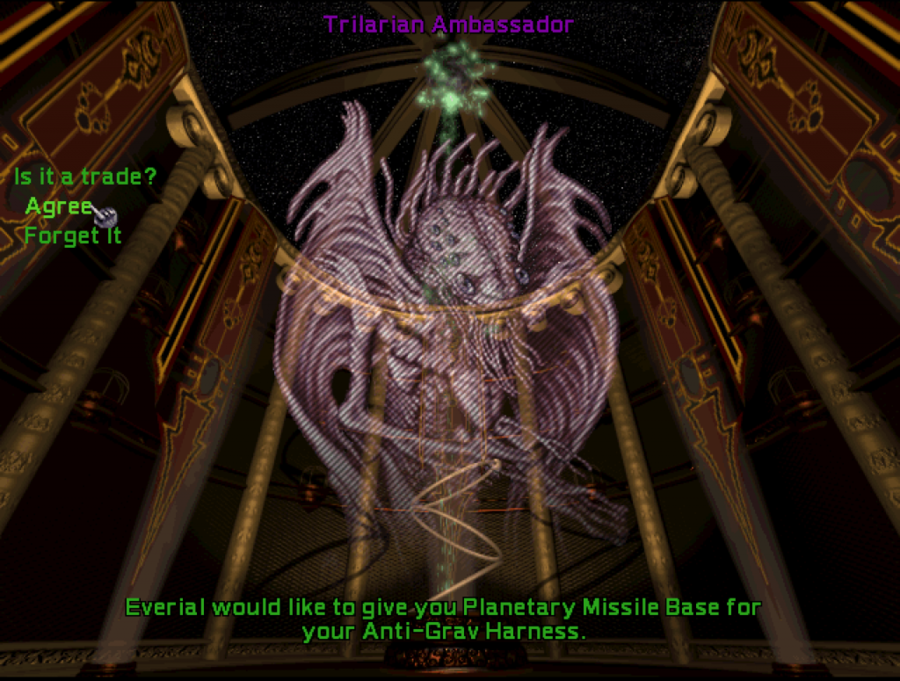
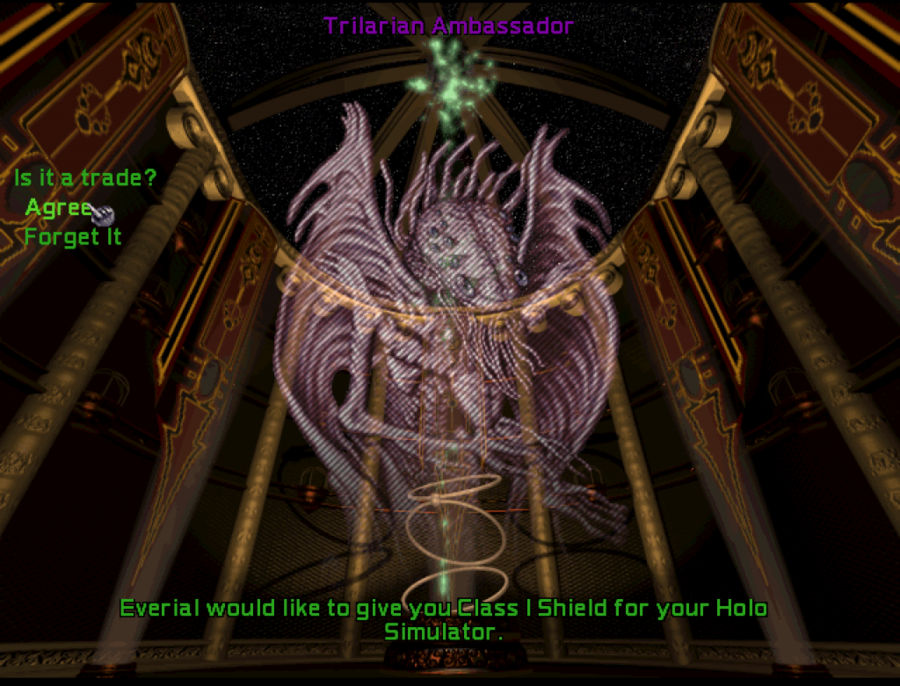
Arrangements are made to permit trade between the two territories, free exchange of information, and significant exchange of technological data. Amongst what the Republic gains from these technological exchanges are designs for equatorial networks of surface-to-orbit missile launchers, the means to generate protective energy bubbles around ships, advanced life-support systems for ship life pods, some Trilarian xenological innovations, and more.


The alliance with the Sakkra that was planned is negotiated, and a technology exchange made for advanced sensors technology. Once again, Nations sensors technology advances the Republican state of the art.

A year later, higher-powered hyperspace drives are developed, taking advantage of the power output of fusion reactors for faster propulsion in hyperspace and normalspace. Ship drives across the Republic are updated as they put into port, cutting travel times across the Republic. The Alert comes out of refit, joining her sister ship back on active duty.


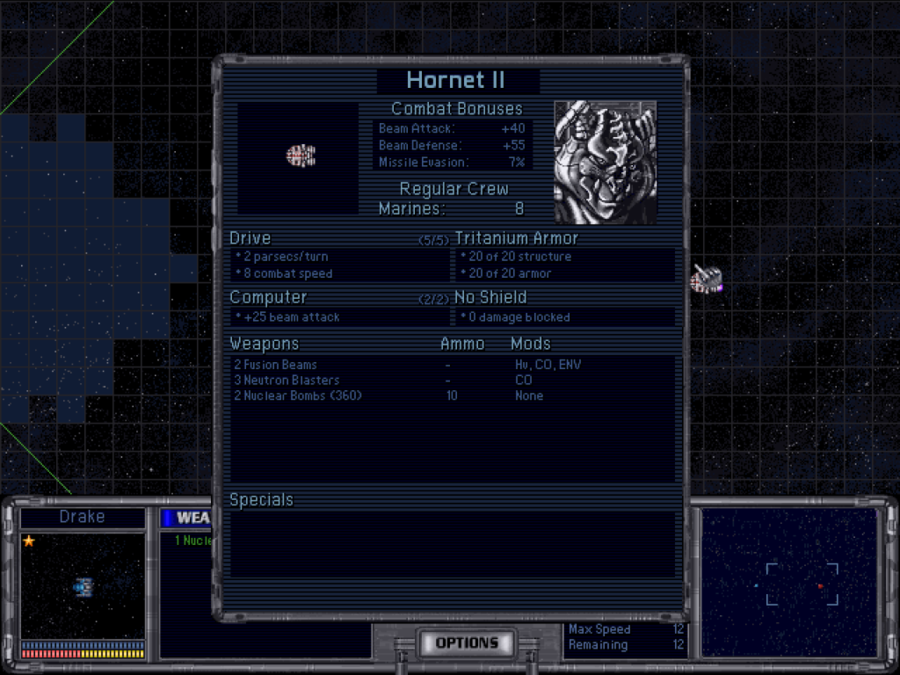
In 2889, the Republican Exploratory Corps scouts out Lesath and Burin. The mission to Lesath does not go smoothly. A Klackon colony had just been established on Lesath a year ago, and a Klackon military vessel in-system opens fire on the Sir Francis Drake with its heavy electron stream weapons from long range. Despite the extended tracking times of these weapons, no hits are scored, and the Sir Francis Drake is able to flee the system with valuable data on Klackon military technology. Klackons appear to have access to an alloy very similar to Isozaki Metal, but are limited to old-style nuclear drives. The weapons on the Klackon warship are all fixed forward mount beam weapons, both heavy electron streams with boosted output and long tracking times, and smaller weapons that may possibly fire bursts of hard neutron radiation to interact destructively with enemy hulls and kill crew through lethal radiation exposure. The Navy is confident that the current Vigilant design would have a distinct edge against this Klackon warship design.
The enemy fusion beams have the Continuous and Enveloping modifications. Continuous weapons fire a long-lasting beam rather than discrete bursts of energy, allowing them to correct targeting more easily and gaining an accuracy bonus. Enveloping weapons burst on impact and hit the enemy from all four sides, increasing damage on impact. The neutron blasters are more advanced beam weapons, modified to be Continuous; they kill security forces on their target as a side-effect of damage, making boarding actions easier if you have a way to board.


Following this skirmish, the Klackon issue harsh territorial demands via comms probe, which the United Republic rebuffs. With this threat apparent, the Navy is ordered to redeploy to the Weg system. The Nations report that they are now at war with the Star Empire in the same year. Although Republican diplomats attempt to broker a peace, the Nations rebuff the proposal for now. By 2893, the fleet is on station at Weg, covering it against potential Klackon aggression. The threat of the Unified State is now considered secondary by Republican strategic planners.
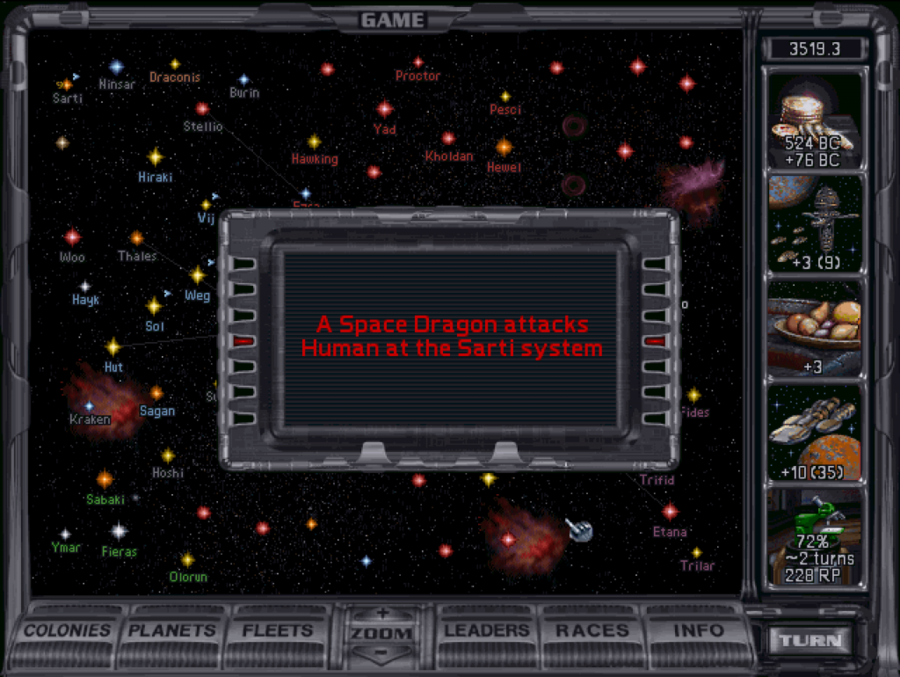
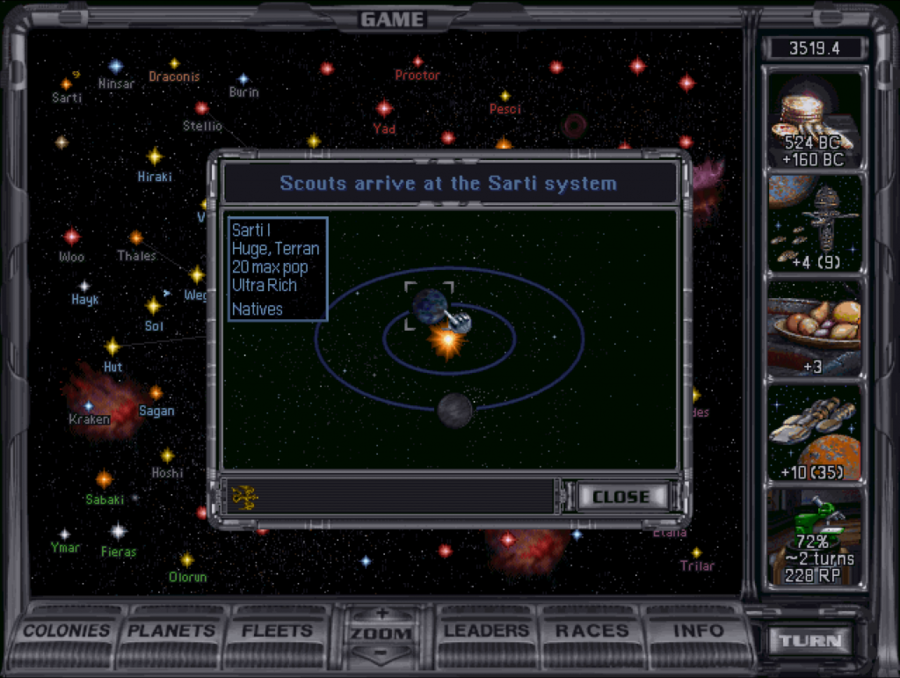
A year after the Navy arrives to reinforce Weg, the RES Leifr Eriksson arrives at the Sarti system in the far galactic northwest. A communications probe launched by the Eriksson reports sensor data on the system- including a huge Earthlike world with staggering mineral wealth and evidence of low-technology cities on its surface. It also reports the advance of a large quasi-organic structure with a metallic alloy hide toward the ship. The Leifr Eriksson never returns from Sarti. 136 years after its commission and after distinguished service across the western portions of the galaxy, the United Republic's first FTL ship is lost in action.



The same year that the RES Leifr Eriksson is lost, the RNS Philadelphia leaves the shipyards at Earth, marking the first service of the Republic's new flagship. Just as she leaves the shipyards, however, new refinements in coilgun technology are revealed, along with emitter stations to screen hazardous radiation from reaching planetary surfaces. She is sent back to drydock to replace her weapons systems and install the new shielding technology from the Star Empire, while new designs are planned for the Vigilant-class. The Philadelphia's two primary forward turrets and her two small defensive turrets are replaced with triple-barreled mounts set in a single turret, allowing a much greater weight of fire. The Vigilant redesign replaces her secondary turrets with high-velocity armor-piercing turrets, the forward secondary turret with a triple-barreled mount, as well as adding a shield emitter to the design. The Philadelphia's refit is finished a year later, and she is dispatched to Weg to reinforce the Vigilant and Alert.
Auto fire requires two levels of miniaturisation, and allows the weapon mounting it to fire three times with somewhat reduced accuracy. With our battle scanners and the naval academies training our crew, our base accuracy is high enough that this is definitely an increase in expected hits.


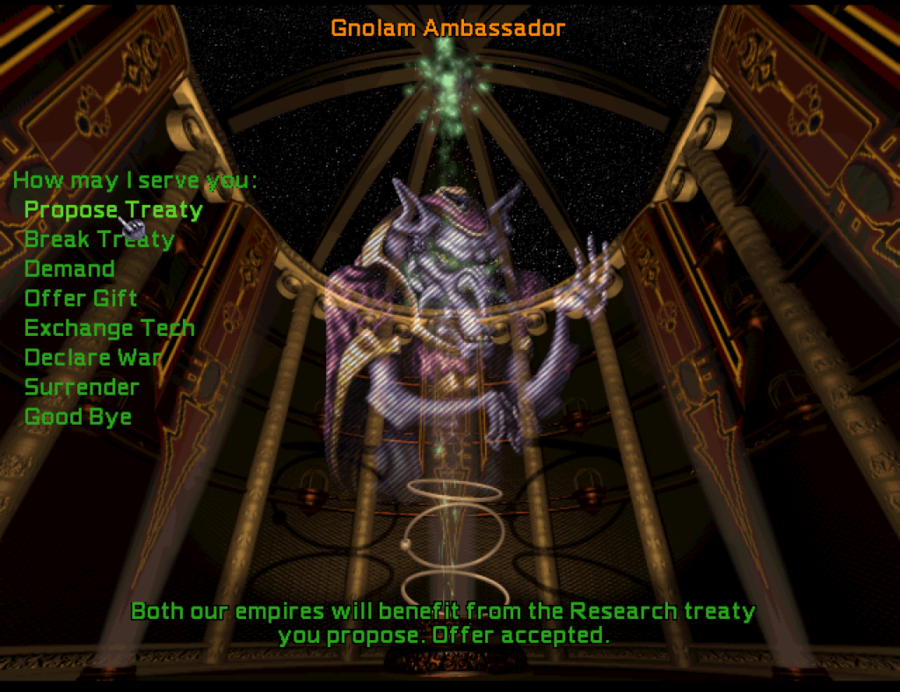
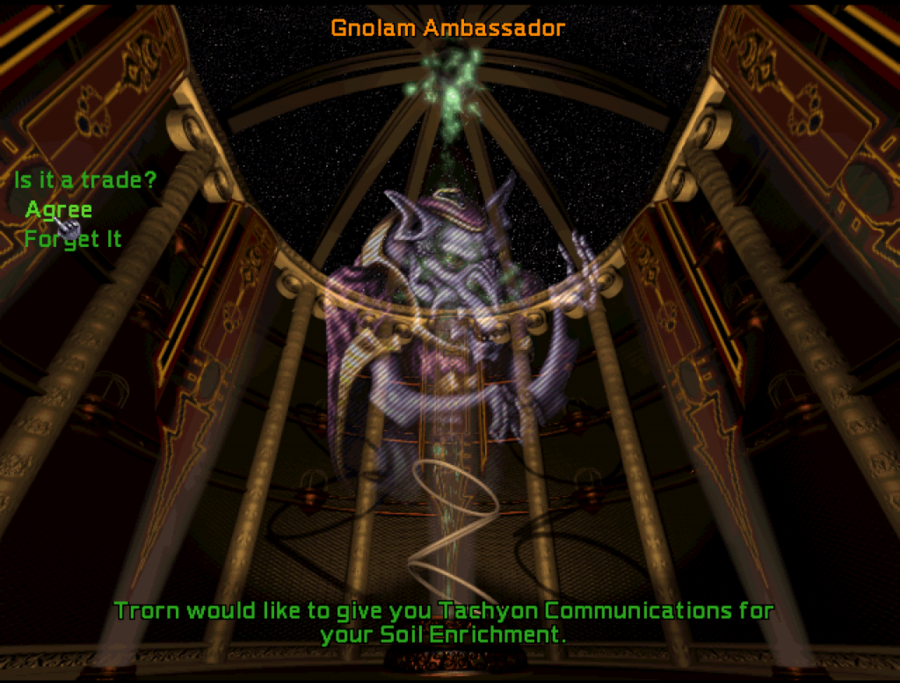
In the same year of 2896, a message is dispatched through the Nations from a new colony to the Nations' south. The Nations have encountered a species known as the Gnolams united under the Commonwealth of the Compact. The first diplomatic message from the Commonwealth of the Compact to the United Republic is scathing:
"A species that would choose to ally with such barbarians as the Sakkra Nations must surely be contemptible. We are assured in the protection of the Creator of All Things, and through our Compact with the Creator we shall be victorious over all our enemies. We pray that you prove our assumptions wrong, but hold little hope that such shall be so."
Despite this rough beginning, the Commonwealth of the Compact proves amenable to negotiation, with trade and information flows rapidly assured. Perhaps even more fortunate, the Commonwealth proves willing to trade information on technology to generate focused tachyon bursts for long-range FTL communications. Suddenly, the United Republic is now longer bound to the cumbersome mechanism of communications probes for interstellar communications, and the time for messages to travel in the Republic shrinks drastically. Trade and naval logistics experience a massive boom. The Navy begins to plan the Reykjavik and London as sister ships to the Philadelphia.
New communications technology improves the command points generated by orbital stations, making it easier to maintain larger fleets.
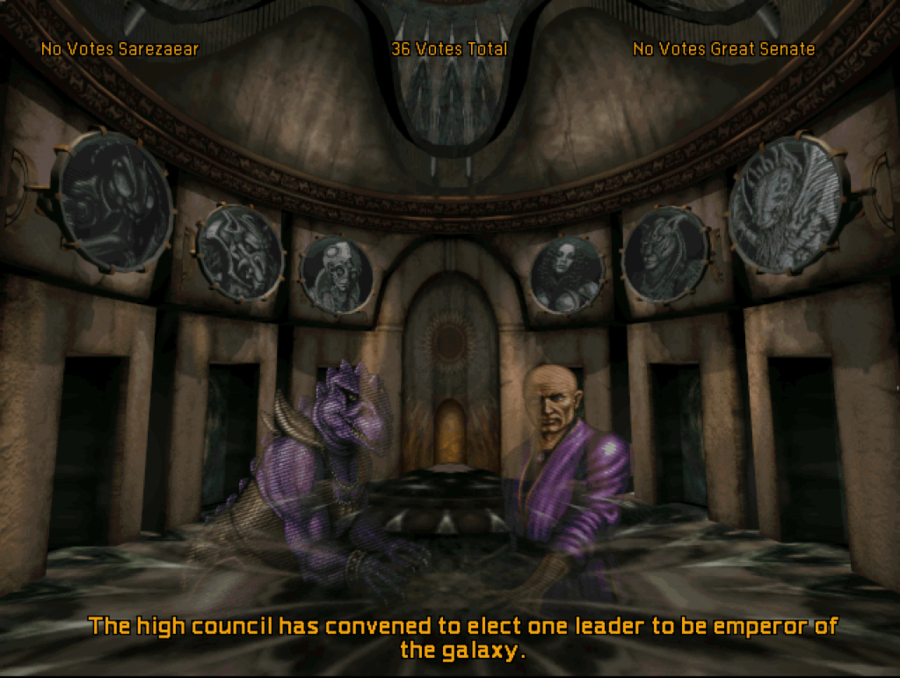

A year later, the Great Lord of the Nations proposes a grand diplomatic summit bringing together all the governments of the galaxy to discuss a radical new proposal. The story of how the different Nations joined together under a single Great Lord, of how the Lakes/Atlantic Federation, Icelandic Republic, and Commonwealth of England formed the United Republic by diplomatic agreement, and how the Psilons joined in the Union of Peace when it became clear one state's control of atomic weapons gave it an insurmountable strategic advantage over the other Psilon states have inspired the Great Lord. Perhaps a Great Lord of the Galaxy can be agreed on. Six of the eight galactic governments agree to long-range communications for the summit, and an extended series of talks ensues. When all is done, the Star Empire, Commonwealth of the Compact, and Union of Peace have stated that if all governments agreed, they would be willing to join under the leadership of the United Republic. The Nations do not find this an acceptable outcome, and it is generally agreed that no 'insurmountable strategic advantage' exists on either side. For now, the proposal of a united galaxy is set aside. The Klackon and Unified State never joined the talks, and the Enlightened Council of Matrons refused to support any candidate for leadership.

Following the talks and in recognition of the Commonwealth of the Compact's support, the United Republic extends full reciprocal recognition of the Commonwealth's territorial claims and pledges to avoid hostile action against the Commonwealth. As the Philadelphia is now on station at Weg, the Vigilant and Alert are refit to the latest design.
This year also marks a historic first for the United Republic. As the Forge finishes constructing screening generators to shield it from the radiation output of Weg, temperatures and radiation levels on the Forge drop to much more reasonable levels, reducing the strain on the planet's infrastructure.


Two years later, a year after the report of the very disappointing Xendalla system's contents, NordPharm announces a great expansion of its operations in the Weg system, and reveals crop genetics tweaks calibrated to the conditions on Nieuw Vlaanderen that should result in massive increases in crop output on the planet. A period of investment and reorganisation ensues.
You can only have four colony leaders and four ship leaders at once. If you fill up, it is often a good idea to fire a weaker one to allow new and better leaders to show up. Our glassy-eyed child Ailis gets the boot in favor of the very awesome Electra. Also worth noting is that leaders have different experience levels, which will VERY slowly drift upwards. Skill effects are set by the leader level of 1-5 times the base level of the skill; expert skills, marked with an asterisk, are 1.5 times the effect they would normally be at their level. Colony leader levels are Administrator, Director, Magistrate, Commissioner, and Governor. Ship leader levels are Commander, Captain, Commodore, Rear Admiral, and Admiral.
It is at the turn of the 30th century that a military fueling and sensors station is established in orbit around one of the gas giants of Mulban, providing a logistics base that the Navy can use to finally launch offensive operations against the Klackon. The fleet is on station and primed for the outbreak of war.
Ironically, this same year, the Republican government succeeds in bringing the Nations and the Star Empire to the table to end their war. No systems changed hands in the years of fighting.
Xenology Report: Psilons
Psilons are a gracile humanoid species with three eyes and an enlarged cranium, adapted for low-gravity environments. Average mass is only 45 kilograms, despite height comparable to Human norms. Sexual dimorphism is nearly undetectable to Humans; young are apparently traditionally nourished by synthetic chemical nutrient formulas. Mating is monogamous and for life, and Psilons who have lost a mate almost never remate. Emotional affect is flat, but a quiet loyalty to mates, young, and friends is evident. Although the Psilons we have met are evidently uncommonly intelligent for their species, we nonetheless estimate that average Psilon intelligence exceeds Human norms by at least an order of magnitude.
The Psilon government is reported as 'the Union of Peace', a technocratic autocracy with the heir to the current ruling Director promoted meritocratically through the serving bureaucracy. The Union of Peace directly controls major heavy industries for strategic purposes, while encouraging a highly entrepreneurial and competitive technology sector of venture companies and universities that vigorously seek out any possible innovations to exploit for wealth and status. Psilons have no religious or supernatural convictions whatsoever, and appear to have only developed a concept of 'religion' upon contact with other sapient species.
The Union of Peace was originally founded during a period of global international struggle immediately after the development of the atomic bomb within one of the rival Psilon states. Upon producing a stockpile of bombs and suitable long-range delivery systems, the government controlling this advance informed all other states that it possessed an insurmountable strategic advantage, and that it sought the concession of all other rival governments. Failure to comply would result in usage of this technology. Within one month, all other Psilon governments had capitulated without protest and the period of internal Psilon wars was at an end. Kirsus and her crew report that there is little sense of loyalty amongst the general populace to the Union of Peace, but little desire for rebellion. Essentially all Psilons agree that the Union of Peace is run for its own benefit at the expense of the general population, but the administration is run efficiently and conditions are not at all intolerable, while the costs of rebellion would be catastrophic. As such, the status quo and stability are regarded as the best possible outcome.
Psilon population units assigned to science produce significantly more research, they are Creative and develop all possible technologies in a field when they research the field, and their low-G nature makes them less efficient on normal-G worlds and weaker as ground troops. As might be surmised, they are a Dictatorship.
Xenology Report: Trilarians
The Trilarians are bizarre aquatic lifeforms that breathe through a highly efficient gill apparatus adapted both to water and air. Average mass is 85 kilograms. Despite their bizarre appearance, their tentacles are extremely dexterous and capable of fine manipulation comparable to the hands of most other sapient species, permitting their use of advanced technology. Through high-energy brain structures whose method of function is not understood by Trilarian or Human scientists (although it is determined that the energy input fueling them appears to come from stable microportals to other spatial dimensions), Trilarians are capable of manipulating the local structure of hyperspace through concentration. It is almost certain that this is an artificially-engineered capability. Trilarians form stable mating bands of approximately 2-10 unrelated male and female adults in what is essentially a 'group marriage' with new entrants negotiated by all existing members; offspring of the mating band are raised by all members of the band with rotating duties.
The Trilarian government, the Empire of the Planet of Trilar and of the Stars (more usually the 'Star Empire'), is a hereditary monarchy passed to the eldest child of either sex of the previous Emperor and Captain of the People's mating band. Autocratic political and economic controls exist, but are essentially moderate; industries are run under Imperial charter by private groups and political controls focus primarily on clamping down on rebellious or proto-rebellious groups. The dominant religious belief holds that the ancestors of the Trilarians were the 'gods of Antares', who once roamed the heavens with divine power until their rule was challenged by the jealous 'gods of Orion'. A great war in the heavens ensued, until the gods of Antares were cast down to Trilar 'amidst death and flame' and their divinity stripped from them. Given the engineered capabilities in the Trilarian brain, it is considered highly probable they once were a starfaring species who lost their technology in some war.
Trilarian cultural mores appear to strongly prioritise duty, honor, and honesty. Although the Emperor rules autocratically and with theoretically unlimited power, the traditions of the Star Empire encourage the Emperor to exercise power in a moderate fashion. The Star Empire's subjects appear to be reasonably content with existing political institutions. Despite its autocracy, the Star Empire can almost certainly operate as a safe friend to the United Republic.
Trilarians are Aquatic, and treat 'wet' (tundra, swamp, ocean, and terran) worlds as more environmentally friendly. On ocean and terran worlds, they can support more population than most races can on terran worlds, and they produce 3 food rather than the default 2 food per farmer on a fertile world. They are also Transdimensional, and move significantly more quickly both strategically through hyperspace and tactically in battle. And, yes, they are another Dictatorship.
Xenology Report: Elerians
Elerians are a quasi-mammalian humanoid race with females of the approximate height and mass of Human males. No Elerian males have been directly observed, but Elerians appear to find it amusing that Human males are the larger sex- we may assume that size dimorphism runs the opposite direction amongst Elerians. The very minimal telepathic capabilities that have been observed in other sapient species in a laboratory environment are, amongst Elerians, greatly amplified, and it appears that telepathic communications are their normal means of communication at 'voice' distances, although they have a spoken language for long-range transmission.
Elerian society can be described as 'militaristic syndicalist feudalism'. All professions in Elerian society are controlled by 'guilds' or 'unions' controlled by Matrons (or, occasionally, depending on the guild, Patrons) over local guild branches who owe fealty to Matrons over wider areas, up until the Council of Enlightened Matrons that contains the heads of all guilds in all Elerian territory. The leader of the Council is the Enlightened Matron of the Commanding Soldiers, the Guild of Commanding Soldiers being the dominant and ruling guild over all Elerian society. Many guilds are sex-restricted; all military guilds are exclusively female. The highest-status male-only guild is the Guild of Philosophers, a group of contemplative mystics who are regarded as the 'husbands of the Matron Goddess'. Philosophers apparently develop extremely powerful telepathic abilities beyond even the general norms of Elerian society, and it was Philosophers studying the minds of Human settlers from parsecs away that led to the Elerian knowledge of English. All members of Elerian society must petition to join a guild to pass to adulthood; no work outside the auspices of the guilds is tolerated. The military guilds, although relatively small compared to the militaristic classes of society in the Unified State, draw the cream of female talent in the society.
The guild system rigidly stratifies society, with the only possible social mobility being vertical movement through one's guild. All members of society do join guilds, which provide guaranteed employment for life for all members, and it appears support of the social system is generally high amongst those Elerians we have any contact with. Like the Nations, the guild system under the Council of Enlightened Matrons is autocratic yet decentralised.
Elerians have a feudal government, bonuses to ship piloting and gunnery, and Telepathic powers that give them a wide range of advantages in espionage, diplomacy, and war. Due to their Philosopher caste, they are Omniscient, and can monitory all fleets and colonies of all empires at all times.
Xenology Report: Gnolams
Gnolams are quasi-mammalian humanoids adapted for low-gravity environments. Individuals average 120 centimeters in height and 40 kilograms in mass. All Gnolam senses appear to be mildly more acute than Human norms, and luxury, beauty, and comfort in food, drink, clothing, and environment are greatly prized by most Gnolams. Mating is monogamous and for life, and mediated by formal religious ceremonies similar to many Human traditions. The two sexes appear to be formally equal under law and eligible for any political, economic, or religious position, although, as with Humans, young children are more commonly primarily raised by the female parent, who nurses young in infancy.
The Gnolam government, the Commonwealth of the Compact, is a theocratic government under the authority of the Church of the Creator's Compact, and the High Priest of the Church of the Creator's Compact is also the Theocrat of the Commonwealth of the Compact. The Church of the Creator's Compact holds that the Creator of the Universe entered a formal compact with the Church in past ages, granting its favor, protection, and aid in past ages in exchange for them executing their stipulated contractual obligations to teach outsiders of the Creator, live according to its standards of morality, and enjoy the creation which it made for all peoples.
The Commonwealth has been aggressively expansionist in its history, seeking conversion of other Gnolams both by persuasion and by international power politics. Internally, despite its theocratic basis, the Commonwealth is relatively benign, offering a great deal of personal and economic freedom to all those in good standing with the Church. Gnolams tend to be by temperment restless and ambitious, and view the 'enjoyment of creation' as an active religious duty. These factors together have fuelled the rise of a highly competitive capitalistic culture with wide acceptance on all levels of Gnolam society, with little or no interference by Commonwealth legal authorities. The highly competive nature of Gnolam institutions encourages a strong sense of meritocracy, and commercial, church, and government operations are highly efficient and well-run. Social structures outside of the Church are fluid, with upward and downward mobility common, and living standards across the society are high.
Despite these relatively benign policies, it cannot be forgotten that the Commonwealth is an self-perpetuating autocracy without democratic institutions of accountability. Although abuses of power appear to be rare, there is little recourse when they do occur.
Gnolams generate twice as much money per population, also improving the effects of improvements that increase money. The are also Fantastic Traders who get more revenue from trade treaties, building trade goods, and cash crops, and Lucky, never suffering negative random events and enjoying more positive random events. Several earlier GNN news reports reported on Gnolam good fortune. Finally, they are Low-G, like the Psilons, and have a Dictatorship government.
The United Republic in 2900

Industrial subsidies have expanded Earth's heavy industry over the past 20 years, but the development of atmospheric renewal technology has entirely eliminated the need for special industrial waste sequestration. Colonists from Earth and Mars continue to gather on Earth to settle what worlds remain for exploitation on the western rim of the galaxy. Equatorial surface-to-orbit missile bases now ring the planet, providing a strong defense for the capital.

Mars once again is devoted to expanding the RCSPS, and, like Earth, its heavy industry benefits from atmospheric renewal. The heavy development and the diversion of resources to the security services have begun to take their toll on the quality of life on Mars, although conditions, on the whole, are still generally prosperous.

Nieuw Vlaanderen has grown to over 16 billion inhabitants, and is now easily the most populous Republican world. Economic efficiency has dipped during the NordPharm reorganisation, and the planetary economy is suffering a mild recession. Economic analysts anticipate a complete recovery within four years. Industrial workers prepare to lay the keel for the Reykjavik, a planned sister ship to the Philadelphia. Missile defenses, a ground garrison of 70 million, and a naval academy in the orbital naval base mark the military buildup of the past 20 years on Nieuw Vlaanderen.
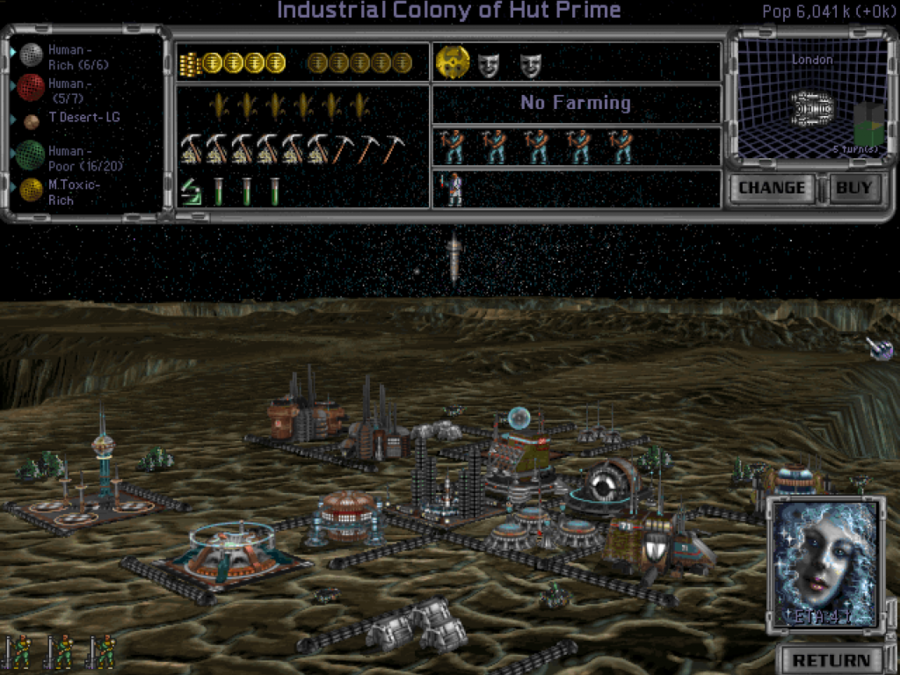
The Forge, although still barren and lifeless, is far less deadly, due to the radiation shielding now encasing the world. Unfortunately, the expense of maintaining the local military buildup and the system-wide recession have hit the Forge's standard of living noticeably. The population hopes for a rapid economic recovery and a return to more comfortable economic conditions. The orbital shipyards have made considerable progress on the London, which should be commissioned within five years.

Over the past 20 years, the Anvil has gone from an underdeveloped backwater dependent on basic industry and Social Democrat transfer payments to a reasonably prosperous and modern world. An orbital base in construction will help secure the planet against any attack once it is complete, after which investors are primed to deploy radiation shielding to moderate the planet's environment.
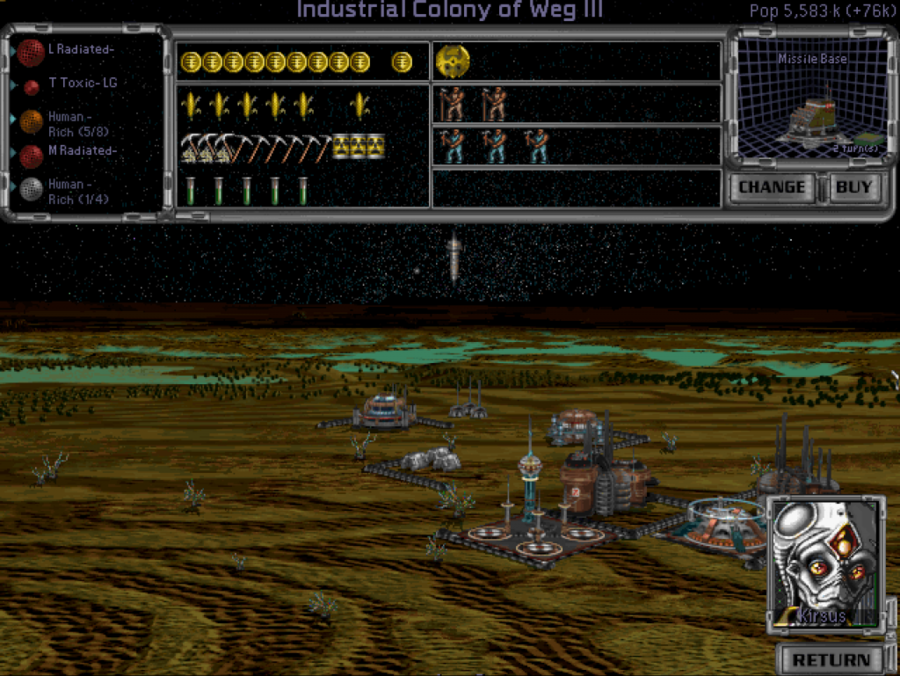
New Greenland has finished orbital fortifications against potential Klackon attack, and has been working on deploying equatorial missile bases. New arcology-cities slowly gain new inhabitants. The small output of the local human technology industry is dwarfed by the output of Kirsus and her Psilon expatriates, who are, in a quiet, understated way, now fierce Republican patriots and a reliable, if tiny, voting bloc for the Liberals.

The colonists of Wotan work at a breakneck pace under overworked conditions to finish an equatorial missile base network. Although accidents are common, the general sentiment amongst Wotaners is that accidents and overwork are a great deal preferable to Klackon warships showing up with no defenses in place.

Laaxaayik has grown to other three billion persons in population, with Puppeteer deployment having greatly boosted local industrial output and a missile base network helping to secure the planet. The population strains under the demands of building further fortifications, and many people on Laaxaayik would prefer a refocus on civilian concerns now that the missile base network is in place.

Cherenkov is still reasonably backwards, having arcologies but no Puppeteer deployment. New pollution processing facilities have cut the strain of waste disposal, and missile defenses secure the world against potential threat.

Naraka's two and a half billion persons are bitterly cynical about the new orbital naval base in construction over their world. They are far behind Republican lines, and, in their view, there are a great many things Naraka could use first before it could use a Naval base, especially considering the strain of maintaining their current infrastructure.

Sheol is still a frontier world with only the basics of modern industry. There is some nervousness about the proximity of the Elerian homeworld, but the colonists hope that they are still out of range of warships without added fuel bunkerage.

The United Republic enjoys profitable trade and mutual recognitions of borders with the Nations, the Star Empire, and the Commonwealth of the Compact. No mutual agreements have been established with the other neighbors of the United Republic, and the general sentiment is that the Klackon certainly must be planning to strike soon. Although the United Republic knows of the Union of Peace in the far northeast, beyond the black holes, it has no reliable contact with them. The Conservatives have built the RCSPS up to 180,000 staff, and plan to begin offensive espionage actions against the Unified State or the Klackon once staffing reaches 200,000.
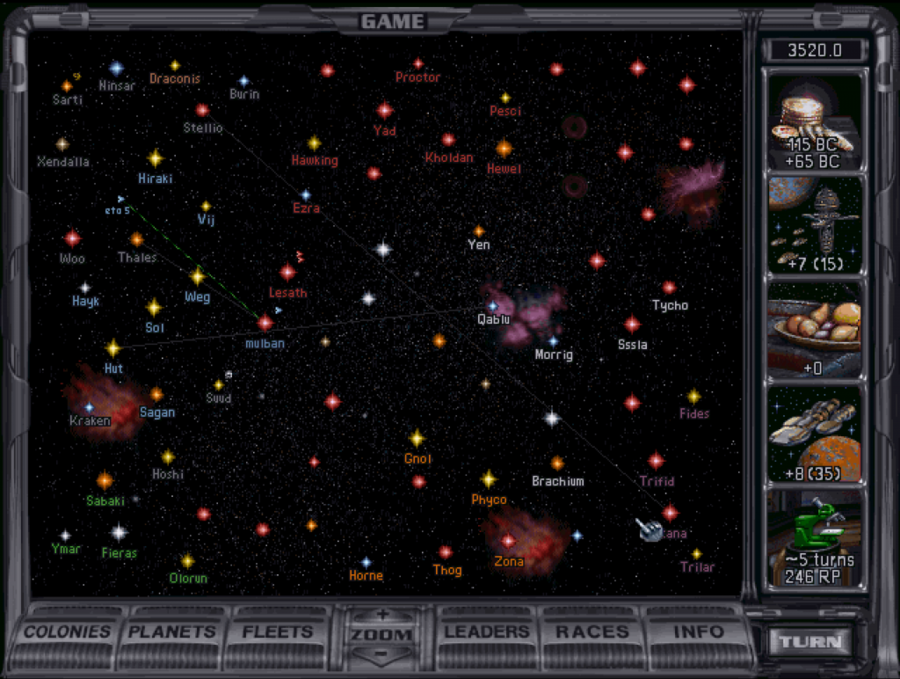
Investment is down over the past twenty years, while increasing populations and the contributions of the new Psilon minority ensure research is up. Commercial shipbuilding has managed to keep pace with demand, and naval logistics are greatly improved by the new network of bases to supply crew, communications, and supplies and by the increased efficiency new communications technology offers. The Klackon spread to the East of the Republic is a notable strategic barrier, and the Unified State has spread to its fourth system.
War with the Klackon is surely inevitable. The only question is when, and under what circumstances.
The Conservatives wish to strike first against the Klackon before the Klackon assault Republican systems; Klackon behavior and the evidence of their operational range from the combat vessel encountered at Lesath indicate both an intent for the Klackon to strike and a somewhat greater operational military range than the Republican Navy enjoys. To this end, they wish to muster mobile surface assault forces to put Republican boots on Klackon soil and seize and fortify Lesath, and complete the London and Reyjavik to reinforce the Navy. Research into infantry and vehicle shields, coilgun refinement, advanced computer targeting systems, and nanotechnological manufacturing tools to aid traditional industry are planned to be supported by research grants. In foreign policy, the Conservatives wish to maintain the current network of treaties as is, preferring not to establish any agreements with the Elerians, and build the RCSPS up to 200,000, then tasking personnel to offensive espionage against the Klackon. The Unified State frontier has fortifications in place and a buffer of empty space between the two powers, so the Conservatives believe that frontier is secure for the moment. They wish to continue fortification and logistic projects across the United Republic, develop the industrial base on established colonies, and support colonisation efforts when all other objectives are dealt with.
Conservative voters only: Conservative military planners are considering the deployment of forces and grand strategy of a war against the Klackon. If Klackon power storage technology can be seized by military forces or espionage, a push to seize and fortify Ezra could be made, which may be a somewhat more defensible position once both systems are fortified but which will almost certainly cost tens of millions more in Republican surface forces' lives. Are Conservative strategic goals a more cautious push to seize only Lesath, or an attempt to seize both Lesath and Ezra? Further, do Conservative military planners keep all mobile forces on the Klackon front, or redeploy the Vigilant and Alert to cover the Elerian frontier?
The Social Democrats are deeply divided about the establishment of relations with the Commonwealth of the Compact; many believe that this is a step that should not have been taken. They are, however, in favor of establishing friendly relations with the Council of Enlightened Matrons, believing that friendly relations with the Elerian people will be advantageous and proper. They intend to build up the RCSPS to 300,000 or more, engage in offensive espionage actions against various hostile states, and potentially use the Republican alliance with the Sakkra to divert Klackon attentions to the galactic east, while actively supporting colonisation of the last few available worlds on the western rim, completing the London and Reykjavik, and ensuring all border worlds have both surface and orbital fortifications. Research grants will be focused on RCSPS projects, xenoecology, and nanotech pollution control methods.
Social Democrat voters only: Social Democrat primaries wrangle over the best potential foreign policy for the United Republic. Should relations with the Commonwealth of the Compact be severed, or friendly relations with the Commonwealth maintained? Furthermore, should Republican diplomats seek to divert Klackon attentions by encouraging the Nations to war on the Klackon pre-emptively, or should Nations intervention be reserved for when war erupts with the Klackon?
The Liberal party believes that the Republic's northern frontiers should be secured by attempting to establish friendly and profitable relations with the Council of Enlightened Matrons, while maintaining all other friendships and a policy of peace until war with an enemy becomes inevitable. Once war breaks out, they intend to fight defensively, using superior Republican sensor ranges, drive speeds, and combat efficiencies to crush Klackon fleets as they are dispatched, as they believe that planned Naval buildups should ensure comprehensive combat superiority over Klackon vessels. Economically, they wish to cut industrial subsidies and help the civilian economy to recover, fortify the border systems with missile installations and orbital naval bases, and continue to see innovation, investment, and civilian-driven colonisation thrive. After the development of advanced economic methods and xenoecology, Liberal support for military research may result in weapons, shield, and targeting breakthroughs, to ensure a technological lead over Klackon forces. They intend to keep the RCSPS at current staffing levels and focused on counterintelligence duties only.
Liberal voters only: the extent to which the United Republic should build up the Navy is under debate in Liberal primaries. Should both the London and Reykjavik be completed, or should the Reykjavik be delayed until the situation worsens? Furthermore, should planned military research funding be higher, possibly delaying xenoecological breakthroughs in favor of earlier military advances, or should lower military research outlays ensure military breakthroughs follow xenoecological ones that may allow improvement of planetary environments?